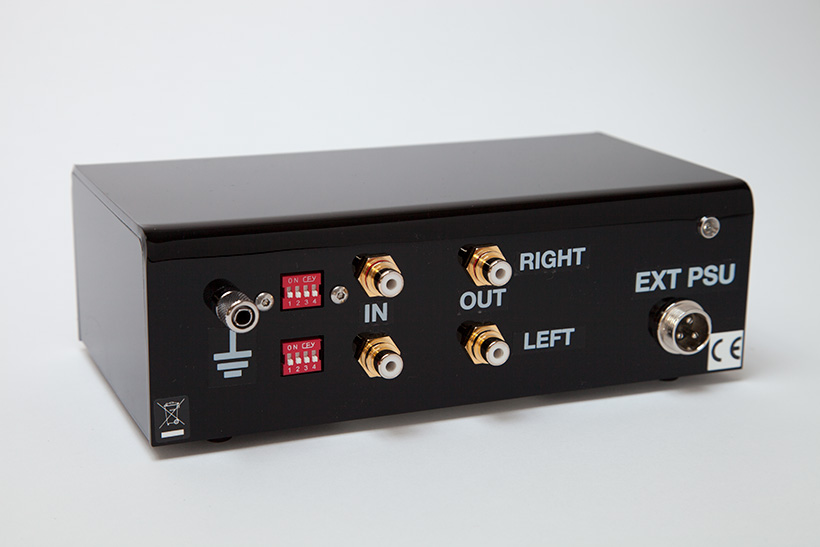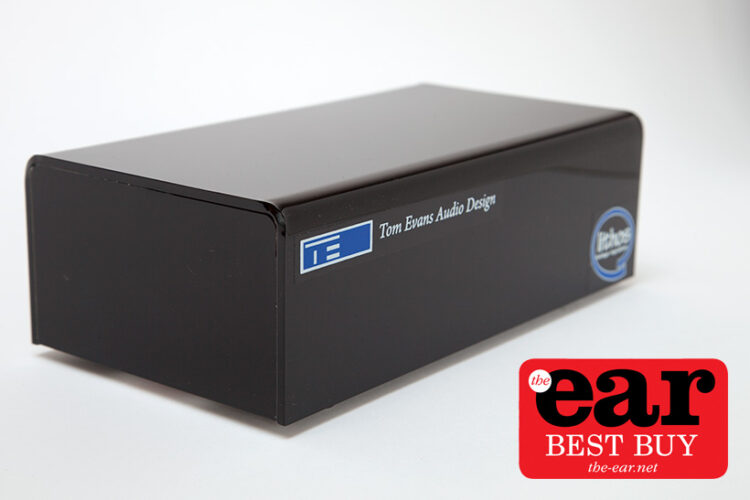Tom Evans is obsessed with noise, or rather he is obsessed with reducing it in his phono stages and amplifiers. So when he gets some new regulation chips in and upgrades his range of Groove phono stages a great deal of enthusiasm can be found to be emanating from Aberbargoed in south Wales. Tom is nothing if not effusive about his creations, and rightly so they are remarkable devices that have been extracting thrill power out of cartridges for over 20 years.
The Microgroove+ X MkII is the second up in his range and has a passing resemblance to the Michell Iso that set this particular ball rolling back in the day. It has a black acrylic case and a separate linear power supply in basic casing, this has a fixed mains cable and a 1.5 metre supply cable that terminates in a three pin, locking plug for the phono stage. Putting the mains transformer at arms length like this keeps transformer radiation away from the signal circuitry. The acrylic box has in and outputs on good quality RCA sockets alongside an earth terminal and two rows of dip switches, these can be used to alter the load impedance to suit different moving coil cartridges. Gain is fixed but you can specify what you require prior to purchase if you have something particular in mind, you can also have it set up for moving magnet cartridges.

Under the lid the reason for the MkII appellation is apparent in Tom’s Lithos 7 regulation chips, these drop noise on the incoming power supply to miniscule levels in two stages. The thinking being that moving coil signals are ludicrously low voltage things and that any noise in the amplification will be added to the signal. When you think that the 0.2mV produced by an MC cartridge has to be amplified by 10,000 to bring it up to the 2 volt output of typical line sources like a CD player. You realise that noise needs to be kept as low as possible in a phono stage. In practice the Microgroove has a total of 60,000 times gain but loses a tenth of that in the RIAA equalisation process so what you get at the output is 1.2 Volts peak to peak. Either way noise of any kind will be an issue. The main difference between this near entry level model and those above it is the amount of regulation employed, more money gives you quieter gain and thus more dynamic range.
In the system with a Vertere MG-1 turntable and Transfiguration Proteus MC cartridge the Microgroove, set at its lowest 112 Ohm impedance. delivers a particularly engaging sound. It makes you close your eyes and go where the music moves you, which means the focus is on the message in the music and not the mechanics of its reproduction. It seems a bit quieter than other stages at this price but that’s less critical than the way it reveals micro dynamics – the small changes in level between notes that are not always apparent. It also flows beautifully, which means that melodies are always clear, which is built on rich detailing of the quiet as well as fundamental notes. It pulls out information at the quiet end of the dynamic spectrum that other stages miss. So bowed strings have more textural depth and this makes them more natural and realistic.

With a Rega Apheta 2 cartridge aboard a Rega RP8 turntable the Microgroove brings out the qualities of voice particularly well, on Tom Waits’ ‘Shore Leave’ (Swordfishtrombones), the gravelly voice can lack clarity with some stages but not here. Now every colourful description of a sailor’s brief moments of freedom are elucidated so well that you can smell the rain and cigarette smoke. The high pitched guitar notes are very cleanly delivered too, Waits has always been good at finding backing musicians and with Little Feat’s Fred Tackett on guitar he hit the sweet spot.
The Microgroove+ is a fast and open sounding phono stage, it is the perfect foil for lazy sounding cartridges or speakers that need a bit of enlivening. It’s not bright or forward and it has plenty of power in the bass but neither does it have the old slipper warmth of some stages. That said altering the load impedance has a marked effect on the balance and if you want a warmer sound it can be achieved this way. Unfortunately there are no indications on the box as to what the different switch settings do so don’t lose the sheet that comes with the unit. But it’s a simple case of the more switches that are on the lower the impedance, and it’s not so much the actual figures that are critical as how the cartridge behaves with different settings. I found that although the Rega Apheta 2 is specified to be used with 100 Ohms, it sounded better balanced at the Microgroove’s 187 Ohm setting.

The results thus far were pretty respectable but not what I was hoping for in terms of dynamics, talking to Tom it became clear that the both the Proteus and Apheta 2 have too low an output for the standard gain setting. When the Microgroove+ had been adjusted for these 0.2mV cartridges things changed dramatically for the better, the resolution seemed greater, you could hear further into each recording, and the dynamics came alive. The Microgroove+ was in the system on the day that the ‘ears’ of Bowers & Wilkins R&D department, Steve Pearce, brought the new and rather special 802 D3 loudspeakers over. We played a number of discs and files which after a bit of tweaking seemed to give the result he was after, but when I put some vinyl on the RP8/Apheta 2 he let out a sigh of relief because not everything really came together. These phenomenally revealing speakers made it so abundantly clear how much better a source the vinyl provided that he resolved to get one of his three unwell turntables up and running, I suggested he ditch them in favour of a turntable like the RP8 or even better RP10, and a phono stage of this calibre, of course.
The Microgroove+ X MkII is a highly resolute and remarkably even handed phono stage that will unearth details you may not have suspected were in the signal. It lacks the thickness that give other stages a greater sense of tonal depth but transparency is very high indeed, its neutrality and low noise means you get to hear an awful lot of vinyl goodness for the money. Just let Tom know which cartridge you have when ordering and all will be very groovy indeed.


